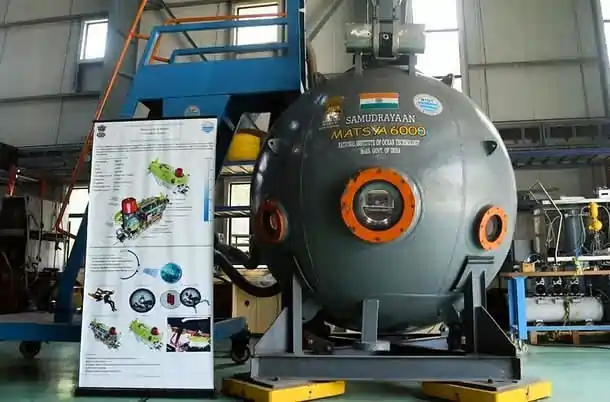New Delhi: In a monumental leap for India’s ocean exploration ambitions, two Indian aquanauts, Raju Ramesh and Cdr. Jatinder Pal Singh (Retd), have etched their names in history by diving to depths of 4,025 meters and 5,002 meters in the Atlantic Ocean on August 5 and 6, 2025. Conducted aboard the French submersible Nautile in collaboration with IFREMER, France’s Marine Research Institute, these record-breaking dives mark India’s deepest human exploration of the ocean, placing the nation among an elite group of fewer than six countries capable of such feats. This achievement, led by a team from the National Institute of Ocean Technology (NIOT) in Chennai, serves as a critical stepping stone for India’s Samudrayaan Mission, a cornerstone of the flagship Deep Ocean Mission aiming to send three aquanauts to 6,000 meters by 2027 in the indigenously developed MATSYA-6000 submersible.

A Record-Breaking Milestone
The dives represent India’s deepest human excursions into the ocean, surpassing previous records set by Indian scientists who reached 3,800 meters in 1997 aboard the USA’s Alvin submersible and 2,800 meters in 2002 using France’s Nautile. On August 5, Raju Ramesh, a Senior Scientist at NIOT, descended to 4,025 meters, followed by Cdr. Jatinder Pal Singh, a retired Navy Commander, who set a new national record by reaching 5,002 meters the next day. Each dive lasted approximately seven hours, with a total mission duration, including descent and ascent, of about 9.5 hours.
The NIOT’s five-member team, comprising Sh. Palaniappan, Dr. D. Sathianarayanan, and Sh. G. Harikrishnan, led by Dr. Ramesh Sethuraman, Scientist G and Group Head for MATSYA-6000, embarked on this mission from IFREMER’s research vessel L’Atalante off Lisbon, Portugal, on August 3, 2025. During the dives, the aquanauts performed critical tasks, including unfurling Indian and French flags, collecting samples using manipulator arms, managing buoyancy, tracking trajectories from the ship, and operating acoustic telephone communication systems, which are vital as radio waves cannot penetrate deep water.
Union Minister Dr. Jitendra Singh, overseeing Science & Technology, Earth Sciences, and other portfolios, announced the achievement on August 14, 2025, emphasizing its significance. “India now joins an elite club of less than half a dozen nations to have ventured so deep into the ocean,” he said, expressing personal pride in Cdr. Singh, a Jammu native, whom he described as “a son of my neighbourhood achieving this for India.” Singh highlighted that this milestone, coming just four weeks after Indian astronaut Group Captain Shubhanshu Shukla’s successful mission to the International Space Station (ISS) via AXIOM-4, underscores India’s scientific ambition and progress toward Prime Minister Narendra Modi’s vision of a Viksit Bharat.
Prelude to Samudrayaan Mission
The Atlantic dives are a strategic precursor to the Samudrayaan Mission, which aims to deploy three aquanauts to 6,000 meters in the MATSYA-6000 submersible by 2027. This first-of-its-kind, fourth-generation scientific submersible is designed with a 12-hour operational endurance and a 96-hour emergency capacity. It features state-of-the-art systems, including a high-density Li-Po battery, underwater acoustic telephone, drop-weight emergency escape mechanisms, and bio-vests for crew safety and health monitoring. The titanium hull, crafted by ISRO with an 80 mm thickness and a precision deviation of no more than 0.2 mm, ensures structural integrity under extreme pressure.
The MATSYA-6000 completed successful wet trials at L&T Shipyard in Kattupalli, Tamil Nadu, in January–February 2025. Future milestones include shallow water trials up to 500 meters by early 2026, integration and deep-water tests by mid-2027, and scientific explorations in 2027–28. Key development stages involve testing the titanium hull, syntactic foam, variable buoyancy system (VBS), and drop-weight mechanism; open ocean subsystem testing and certification; augmenting research vessels with a Launch and Recovery System (LARS); and establishing on-site business incubator facilities.
Dr. M. Ravichandran, Secretary of the Ministry of Earth Sciences (MoES), highlighted the expedition’s operational insights, noting that the NIOT team gained hands-on experience in pre-dive preparations, piloting, habitability, buoyancy management, descent and ascent procedures, manipulator interventions, deployment and retrieval, trajectory tracking, support system management, acoustic communication protocols, dive planning, and maneuvering. These learnings will directly enhance the development of MATSYA-6000.
Deep Ocean Mission: A Blueprint for the Blue Economy
The Samudrayaan Mission is a key component of the Deep Ocean Mission, launched in 2021 by the MoES with an estimated budget of Rs. 4,077 crore over five years (2021–2026). The mission aims to develop technologies for exploring deep ocean resources, promoting a sustainable Blue Economy, and addressing climate change and pollution. Its six major components include:
- Deep-sea mining and manned submersible development: Advancing technologies for resource extraction and human exploration.
- Blue Economy: Harnessing deep-sea resources to support coastal tourism, marine fisheries, and energy/freshwater initiatives like Offshore Ocean Thermal Energy Conversion (OTEC)-powered desalination plants.
- Ocean climate change advisory services: Providing projections of climate variables on seasonal to decadal scales.
- Exploration and conservation of deep-sea biodiversity: Studying microbes and marine resources.
- Deep ocean survey and exploration: Assessing potential sites and ocean resources.
- Advanced marine station for ocean biology: Translating research into industrial applications with on-site business incubator facilities.
Prime Minister Narendra Modi recently announced the National Deepwater Exploration Mission to explore oil and gas reserves in the sea. With a coastline spanning 11,098 km and a vast Exclusive Economic Zone (EEZ), India holds unmatched potential for marine resources. The country has secured a contract with the International Seabed Authority for deep-sea mineral exploration at depths of 4,000 to 5,500 meters, reinforcing its leadership in sustainable resource harnessing.
Dr. Singh emphasized that oceans and space will be twin pillars of India’s economic growth, aligning with Modi’s vision highlighted in his 2021 and 2023 Independence Day addresses from the Red Fort. He noted that India’s dual achievements in space and sea—exemplified by Shukla’s ISS mission and these deep-sea dives—demonstrate the nation’s scientific mettle. Shukla, the first Indian to visit the ISS, is set to return home this weekend, meet Prime Minister Modi, reunite with his family in Lucknow, and participate in National Space Day celebrations on August 23, 2025.
Indo-French Collaboration and Global Leadership
The Indo-French collaboration with IFREMER provided rare access to the Nautile, one of the few submersibles capable of such depths, following months of negotiations. This partnership offered the Indian team comprehensive training in mission protocols, vessel handling, and recovery operations, mirroring the AXIOM-4 mission’s role in preparing Shukla for India’s Gaganyaan program. Dr. Singh noted that India is transitioning from a follower to a leader in futuristic missions, beckoning global collaboration.
Prof. Balaji Ramakrishnan, NIOT Director, and Dr. M.V. Ramana Murthy, Mission Director of the Deep Ocean Mission, joined Singh in celebrating the milestone, underscoring its significance for deep-sea mining, human submersible development, and ocean climate advisory services.
Overcoming Deep-Sea Challenges
Deep-sea exploration poses unique challenges, such as communication delays via acoustic telephones and the need for drills in power failures or emergency ascents. Cdr. Singh described spending four hours at depth, practicing robotic arm operations in complete darkness, testing CO2 scrubbers, and conducting emergency drills. Dr. Ravichandran explained that acoustic telephones, which transmit sound waves with a few seconds’ delay, are essential due to water’s impermeability to radio waves.
India aims to join the exclusive club of five nations—USA, Russia, China, France, and Japan—with successful crewed deep-ocean missions. The Deep Ocean Mission prioritizes environmentally safe mineral extraction, with MATSYA-6000 equipped with scientific sensors and tools for this purpose.
A Vision for India’s Future
This historic dive aligns with India’s broader push for technological independence, echoing historical resilience against colonial tariffs that once stifled Indian textiles and drawing parallels to Netaji Subhas Chandra Bose’s visionary currency for Azad Hind. As India advances toward becoming the world’s leading economy, the Deep Ocean Mission and Samudrayaan underscore its commitment to sustainable Blue and space economies.
With the MATSYA-6000 poised to explore 6,000 meters by 2027, India is set to redefine global ocean exploration, leveraging its vast marine resources and scientific innovation to drive economic and environmental progress.
Frequently Asked Questions
1.What is the significance of India’s recent deep-sea dive in the Atlantic Ocean?
On August 5 and 6, 2025, Indian aquanauts Raju Ramesh and Cdr. Jatinder Pal Singh (Retd) dived to depths of 4,025 meters and 5,002 meters, respectively, in the Atlantic Ocean aboard the French submersible Nautile. This marks India’s deepest human dive ever, surpassing previous records of 3,800 meters (1997) and 2,800 meters (2002). The achievement, conducted in collaboration with IFREMER, places India among an elite group of fewer than six nations capable of such deep-sea exploration and serves as a critical step toward the Samudrayaan Mission, which aims to send three aquanauts to 6,000 meters by 2027 using the indigenously developed MATSYA-6000 submersible.
2.What is the Samudrayaan Mission, and how does it relate to the Deep Ocean Mission?
The Samudrayaan Mission is a flagship initiative under India’s Deep Ocean Mission, launched in 2021 by the Ministry of Earth Sciences with a budget of Rs. 4,077 crore over 2021–2026. It aims to deploy three aquanauts to 6,000 meters in the MATSYA-6000 submersible by 2027 to explore and sustainably harness deep-sea resources. The Deep Ocean Mission encompasses six components, including deep-sea mining, manned submersible development, ocean climate advisory services, biodiversity conservation, deep ocean surveys, and advanced marine biology research, all aimed at promoting a sustainable Blue Economy and addressing climate change.
3.What are the key features of the MATSYA-6000 submersible?
The MATSYA-6000 is a fourth-generation scientific submersible designed for a 12-hour operational endurance and a 96-hour emergency capacity. It features a high-density Li-Po battery, underwater acoustic telephone, drop-weight emergency escape mechanisms, and bio-vests for crew safety. Its titanium hull, manufactured by ISRO with an 80 mm thickness and precision deviation of no more than 0.2 mm, ensures resilience under extreme pressure. The submersible completed wet trials in January–February 2025 at L&T Shipyard, Tamil Nadu, with shallow water trials planned for 2026 and deep-water tests by mid-2027.
4.How does this deep-sea dive contribute to India’s economic and scientific goals?
The record-breaking dives enhance India’s capabilities in deep-sea exploration, positioning it to tap into the vast potential of its 11,098 km coastline and Exclusive Economic Zone (EEZ) for living and non-living marine resources. India has secured a contract with the International Seabed Authority for deep-sea mineral exploration at 4,000–5,500 meters, supporting the Blue Economy. Union Minister Dr. Jitendra Singh emphasized that oceans and space will be twin pillars of India’s economic growth, aligning with Prime Minister Narendra Modi’s vision of a Viksit Bharat and global leadership in sustainable resource harnessing.
5.How does this achievement compare to India’s space exploration efforts?
The deep-sea dives follow closely after Group Captain Shubhanshu Shukla’s successful mission to the International Space Station (ISS) via AXIOM-4 in July 2025, marking a “double conquest” of space and sea. Both feats demonstrate India’s scientific ambition, with the Nautile dives providing operational training for Samudrayaan, similar to how AXIOM-4 prepared Shukla for the Gaganyaan program. Dr. Jitendra Singh noted that these milestones, backed by Indo-French collaboration and Modi’s patronage, position India as a leader in futuristic missions, contributing to its goal of becoming the world’s top economy.

